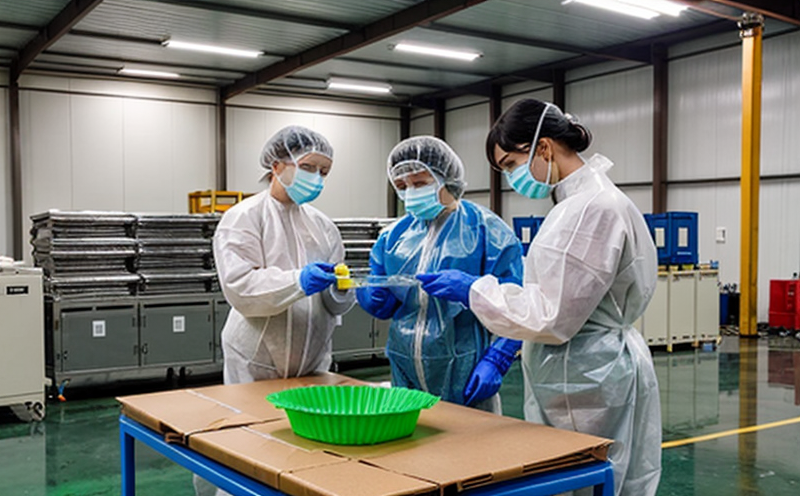ISO 62-5 Water Absorption After Aging
The ISO 62-5 standard specifies a method to determine the water absorption of plastic materials after they have been subjected to accelerated aging. This test is critical for ensuring that packaging materials maintain their integrity and performance under real-world conditions, especially in environments where moisture exposure is a concern.
Water absorption can significantly affect the mechanical properties of plastic materials such as tensile strength, flexibility, and chemical resistance. By measuring water absorption after aging, manufacturers can assess how well their products will perform over time in various environmental conditions. This test helps identify potential weaknesses or degradation that might not be apparent under normal storage conditions.
Accelerated aging simulates the effects of long-term exposure to heat, light, and moisture on plastic materials. The ISO 62-5 method involves exposing samples to these conditions for a specified period before testing their water absorption. This process ensures that any changes in material properties due to environmental factors are accurately measured.
The test procedure typically begins with the preparation of standardized specimens according to ISO standards, ensuring uniformity across all samples tested. Specimens should be cut from larger sheets or blocks and may need conditioning prior to testing (e.g., equilibration at controlled temperature and humidity). Once prepared, they are exposed to heat, light, and moisture for a set duration depending on the specific requirements of the test.
After aging, the specimens undergo immersion in distilled water under controlled conditions. The amount of water absorbed by each specimen is then measured using gravimetric methods or other appropriate techniques specified by ISO 62-5. The results are usually expressed as a percentage increase in weight compared to the initial dry mass.
Understanding the water absorption characteristics of plastic packaging materials is essential for several reasons:
- To ensure product safety and compliance with regulatory requirements
- To maintain package integrity during storage and distribution
- To enhance consumer confidence by providing reliable, durable products
This information can also guide formulation adjustments if necessary to improve the performance of future batches. Properly designed plastic packaging is crucial for protecting contents from spoilage or contamination while meeting sustainability goals.
The ISO 62-5 test provides valuable insights into how well plastic materials withstand exposure to moisture, which is particularly important in industries like food packaging where maintaining freshness and hygiene standards are paramount.
Eurolab Advantages
- Expertise: Our team of experts has extensive experience in conducting ISO 62-5 tests, ensuring accurate results that meet international standards.
- Technology: We use state-of-the-art equipment to perform the test accurately and efficiently.
- Compliance: Our services are designed to help clients comply with relevant regulations and industry best practices.
- Consistency: We maintain consistent quality across all tests, providing reliable data that can be used for decision-making processes.
We pride ourselves on delivering high-quality results that are not only accurate but also provide actionable insights. Our commitment to excellence ensures that you receive the best possible service from our team of professionals.
Why Choose This Test
- Accuracy: The ISO 62-5 test provides precise measurements of water absorption after aging, which is crucial for quality assurance and product development.
- Consistency: By using standardized methods outlined in the ISO standard, we ensure consistent results across multiple tests.
- Industry Recognition: This test is widely accepted within the industry as a reliable indicator of plastic packaging performance under moisture exposure.
- Compliance Assurance: It helps manufacturers comply with various regulatory requirements related to packaging materials and their environmental impact.
Choosing this test means gaining access to valuable information about your product's behavior in real-world conditions, enabling you to make informed decisions regarding design improvements and material selection. This knowledge can lead to enhanced product performance and reduced risk of failure or recall.
International Acceptance and Recognition
The ISO 62-5 standard for determining water absorption after aging has gained widespread acceptance across numerous industries, including packaging, construction, automotive, and electronics. Its global recognition ensures that the results obtained are universally applicable and comparable.
Many countries have adopted this test as part of their national standards or guidelines. For instance, countries like Australia, New Zealand, Canada, and various European nations incorporate ISO 62-5 into their regulatory frameworks to ensure consistent quality across imported products.
The standard's broad acceptance facilitates international trade by providing a common language for discussing product specifications and performance characteristics. This uniformity helps streamline supply chain management and reduces barriers associated with differing local standards.
- Regulatory Compliance: Adhering to ISO 62-5 ensures that your products meet the necessary requirements set forth by relevant authorities in different markets.
- Market Access: Demonstrating compliance with internationally recognized standards enhances market access opportunities for exporters and importers alike.
- Credibility: Using this test adds credibility to your brand, showcasing a commitment to excellence in product quality and safety.
In summary, choosing the ISO 62-5 water absorption after aging test offers numerous benefits that contribute to maintaining high standards of quality and reliability in plastic packaging materials.





